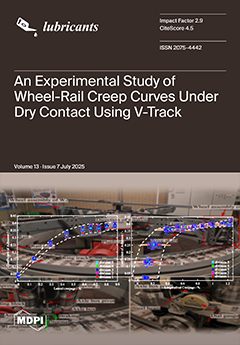To elucidate the key material parameters governing the tribological performance of ceramic composites under dry sliding against steel, this study presents a comprehensive comparative assessment of the microstructural characteristics, mechanical performance, and tribological behavior of two alumina–zirconia (Al
2O
3–ZrO
2) ceramic composites, each reinforced with a 42 vol.% carbide phase: zirconium carbide (ZrC) and tungsten carbide (WC). Specifically, tungsten carbide (WC) was selected for its exceptional bulk mechanical properties, while zirconium carbide (ZrC) was chosen to contrast its potentially different interfacial reactivity against a steel counterface. ZrC and WC were selected as reinforcing phases due to their high hardness and distinct chemical and interfacial properties, which were expected to critically affect the wear and friction behavior of the composites under demanding conditions. Specimens were consolidated via spark plasma sintering (SPS). The investigation encompassed macro- and nanoscale hardness measurements (Vickers hardness HV
1, HV
10; nanoindentation hardness H), elastic modulus (E), fracture toughness (K
IC), coefficient of friction (COF), and specific wear rate (W
s) under unlubricated reciprocating sliding against 100Cr6 steel at normal loads of 10 N and 25 N. The Al
2O
3–ZrO
2–WC composite exhibited an ultrafine-grained microstructure and markedly enhanced mechanical properties (HV
10 ≈ 20.9 GPa; H ≈ 33.6 GPa; K
IC ≈ 4.7 MPa·m
½) relative to the coarse-grained Al
2O
3–ZrO
2–ZrC counterpart (HV
10 ≈ 16.6 GPa; H ≈ 27.0 GPa; K
IC ≈ 3.2 MPa·m
½). Paradoxically, the ZrC-reinforced composite demonstrated superior tribological performance, with a low and load-independent specific wear rate (W
s ≈ 1.2 × 10
−9 mm
3/Nm) and a stable steady-state COF of approximately 0.46. Conversely, the WC-reinforced system exhibited significantly elevated wear volumes—particularly under the 25 N regime—and a higher, more fluctuating COF. Scanning electron microscopy coupled with energy-dispersive X-ray spectroscopy (SEM–EDX) of the wear tracks revealed the formation of a continuous, iron-enriched tribofilm on the ZrC composite, derived from counterface material transfer, whereas the WC composite surface displayed only sparse tribofilm development. These findings underscore that, in steel-paired tribological applications of Al
2O
3–ZrO
2–based composites, the efficacy of interfacial tribolayer generation can supersede intrinsic bulk mechanical attributes as the dominant factor governing wear resistance.
Full article





